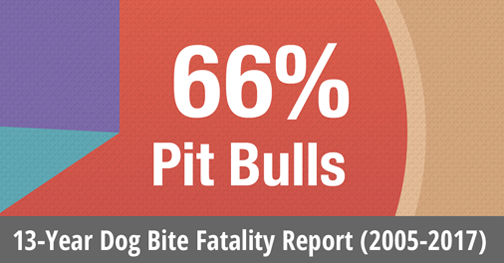Multi-Year Report
DogsBite.org - Today we released our multi-year dog bite fatality report (2005 to 2017). The report identifies the breeds of dogs involved in fatal attacks on humans, victim age groups, number of dogs involved, household factors, criminal charges and more. The 9-page report also examines key changing metrics since a government body last examined this issue in 2000 -- the rise of adults killed by dogs and the increasing number of fatal attacks involving 2 or more dogs.
The report contains six table charts, including a list of all dog breeds involved, a comparison of two periods within the 13-year period, the rising number of adult victims and the decreasing number of attacks inflicted by a single dog. The tables also show the nine states with the most fatal dog attacks over the period, which states brought the most criminal charges after a fatal dog mauling, and in the case of one state, Illinois, how no criminal charges have been filed since 2005.
Download 9-Page Report | Read Full News Release
Austin, TX, May 03, 2018 --(PR.com)-- DogsBite.org, a national dog bite victims' group dedicated to reducing serious dog attacks, releases a multi-year U.S. dog bite fatality report. From January 1, 2005 to December 31, 2017, canines killed at least 433 people. The majority of these victims were ages 10 and older. The 9-page report examines over 20 factors involved in fatal dog maulings and key changing metrics since a government body last examined this issue in 2000.
The 13-year report shows that pit bulls contributed to 66% of all dog bite fatalities. Within this period, deaths attributed to pit bulls rose from 58% (2005 to 2010) to 71% (2011 to 2017), a 22% rise. Rottweilers, the second most lethal dog breed, inflicted 10% of attacks resulting in death. This is a decrease from an earlier period (2005 to 2010) when rottweilers inflicted 14% of the total recorded deaths. Together, these two dog breeds accounted for 76% of all deaths.
The 9-page report examines the breeds involved in fatal attacks on humans, age groups and genders of the victims, the number of dogs involved, family and dog relationships, property statistics, household and time factors, criminal prosecutions following fatal dog attacks and states with the most occurrences. The report also compares two metrics -- the age of victims and the number of attacks involving 2 or more dogs -- to years previously studied (1979 to 1998) ... (Continue reading news release)
Related articles:
02/28/18: Discussion Notes: 2017 U.S. Dog Bite Fatality Statistics - DogsBite.org
02/21/17: Discussion Notes: 2016 U.S. Dog Bite Fatality Statistics - DogsBite.org

